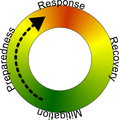Download this article in Adobe Acrobat Reader
Managing a Disaster - Four phases of success (Mitigation)

Essentials for successful handling of a disaster are largely dependent on the responder's ability to efficiently manage such an event. As we will demonstrate, managing a disaster encompasses a cycle of four phases to complete the process: Mitigation, preparedness, response, and recovery.
It is only through careful study, planning, and execution that any response to an emergency can be effective, efficient, and result in successfully reducing the amount of property damage and loss of life.
Mitigating Damage
Mitigation is an attempt to negate or reduce the amount of damage caused by a disaster, or to even prevent such a disaster from even happening. When thinking about mitigation, one must first recognize what risks are present, and what types of disaster could occur. It would be impossible to create long term strategies for mitigation, without first knowing what type of emergency could happen.
On May 15, 1929, a fire broke out at the Cleveland Clinic in Ohio, and 125 people lost their lives in the fire. It was determined that deterioration of nitrocellulose film occurred, resulting in a flameless combustion. It was the release of nitrous fumes that became the root cause of the majority of deaths, and not the actual fire associated with the event. A look back at the event reveals several key mitigation standards not employed at the time, could have prevented the disaster, as well as reduce damage and loss of life caused. These tactics though were not commonly practiced then, are now part of standard safeguards today.
- The safe storage and disposal of hazardous agents
- Education about hazardous substances at a location by occupants, as well as public labeling of such properties, so that those around can readily identify possible hazards
- Structural design of public buildings to expedite safe evacuations
- Efficient alert systems and evacuation plans
- Informed response and recovery teams
On April 15, 1912, over 1500 passengers lost their lives aboard the Titanic ocean liner. Several factors contributed to the sinking of the Titanic, as well as the death toll that incurred.
- Complacency about the possibility of the ship sinking. Deemed “unsinkable”, many did not heed safety regulations in place for such an event.
- The structure of the Titanic allowed for a chain event to occur, once flooding started in the lower bulkheads.
- Inadequate training for lifeboat launches lead to confusion of launch processes, as well as capacity standards for each boat.
- The lookout officer, Fred Fleet, could have spotted the iceberg that ultimately caused the sinking much sooner, had he been oriented on where to locate binoculars commonly used by the lookouts.
Unfortunately, many of today's regulatory standards have been placed due to the learning curve of experience associated with studying past disasters. However, with proper planning, most disasters can be mitigated, and the cost associated with damage from these calamities can be reduced significantly.
Mitigating an emergency can drastically reduce the final financial numbers associated with a disaster. In the US, hurricanes hold a resoundingly large amount of the most expensive disasters in history. With an estimated cost of over 125 billion, Katrina tops the list. However, with mitigation plans, those numbers could have been significantly higher, and with continued planning, could be dramatically decreased.
To help organizations better prepare and initiate effective mitigation protocols, funding and grant programs have been put into place, and many are a result of the Robert T. Stafford Disaster Assistance and Emergency Relief Act (Stafford Act).
- FEMA Pre-Disaster mitigation Program
- Federal low interest loans
- Hazard Mitigation Grant Program (HMGP)
- Flood mitigation Assistance (FMA) program
- Severe Repetitive Loss Program
- National Flood Insurance Program
- Repetitive Flood Claims Program
Read the rest of the article
- What is a disaster
- The evolution of man and nature as a direct result of disaster
- Managing a Disaster - Four phases of success (Mitigation)
- Managing a Disaster - Four phases of success (Preparation)
- Managing a Disaster - Four phases of success (Responding)
- Managing a Disaster - Four phases of success (Recovery)
- Disaster Management - An organized structure in the midst of a chaotic event
- Disaster - An inevitable future

